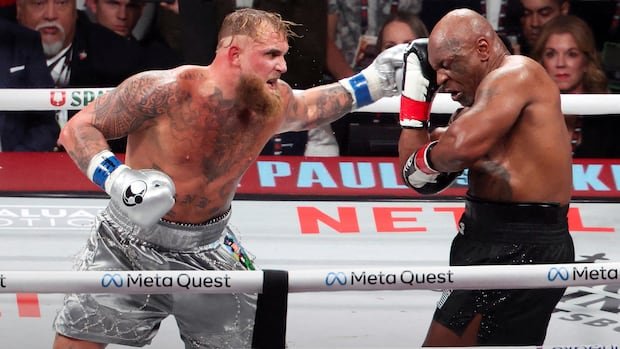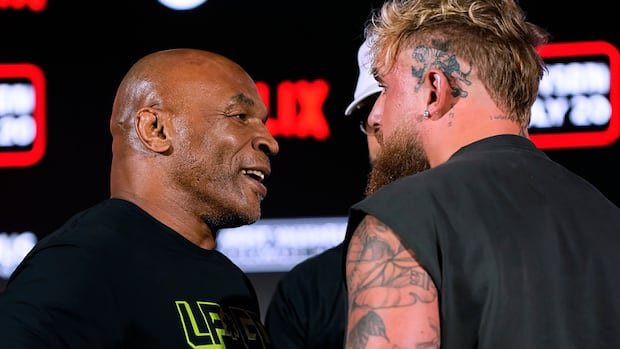When evaluating the success of last Friday’s *ahem* boxing match between Mike Tyson and Jake Paul, we should start by tallying dollars – Paul pocketed a reported $40 million US, while Tyson grossed $20 million.
Most Valuable Promotions – the company staging the event – confirmed by Monday morning that it drew 72,300 spectators to AT&T Stadium, and generated $18.1 million in gate revenue, a record for a boxing match outside Las Vegas. For context, Manny Pacquiao’s 2010 showdown with Josh Clottey did $6.4 million in ticket sales at the same venue, while boxing superstar Saul “Canelo” Alvarez did just over $9 million at the gate for his May 2022 win over Billy Joe Saunders.
So yes, measured by the money it made for fighters and promoters, the show, unlike the featured bout, was a knockout.
But we haven’t talked enough about what it cost – and not just the $2 million a personal injury law firm coughed up for the “Owner’s Experience VIP Package,” which included seats at the ring apron and autographed gloves, among other perks.
The event was streamed on Netflix, so it cost you the price of a subscription if you didn’t already have one. It’s a bargain compared to the pay-per-view rate MVP would have charged if it had partnered with a traditional broadcaster, but it’s still something. And if you actually enjoyed watching a 58-year-old man with a long list of health problems stagger to the ring, then lurch around it while a healthy 27-year-old peppered him with punches, maybe Friday’s main event cost you, upon sober reflection, some self respect.
The bout cost Tyson another blemish on his once flawless record. He’s now 50-7 with two no-contests.
And Paul?
He entered Friday ranked 106 out of just over 1,500 active heavyweights in the world, according to Boxrec, the online records database. A boxer’s ranking typically rises after each win, but five days after beating Tyson over eight dreary rounds, Paul had fallen to 128. To the extent that Paul, a YouTuber turned boxer, has a signature victory, Friday was it, and it cost him 22 spots in Boxrec’s rankings. In the eyes of people – and computers – that understand boxing, defeating a legend diminished the winner.
WATCH | Netlfix’s Tyson-Paul spectacle dealt with tech issues during live broadcast:
Boxing fans looking to watch Netflix’s livestreamed fight between Mike Tyson and Jake Paul faced frustrating buffering and delays from the streaming service. With more live sporting events expected to go online, technical issues make some experts wary of rapid growth.
So from here the obvious questions are whether beating up on the husk of Mike Tyson dented Paul’s appeal, and whether the formula that made Friday’s fight the most viewed boxing match ever is fatally flawed.
The answer to both questions: probably not.
Partly because a large portion of the 108 million people who watched the fight don’t know enough about boxing to realize that Paul and Tyson served up a dud. If they knew that much they’d have known better than to harbour expectations for a prize fight involving an unproven pro, and a former champ who hasn’t looked dominant since the night Tupac was shot in Las Vegas. If you can con all those people once, you can get many of them again. I’d like to think we’re smarter as a species and a society, but every day evidence accrues that we’re not.
Viewership numbers dwarfed Floyd Mayweather’s best nights – he drew 4.4 million pay-per-view buys against Pacquiao, and 4.3 million when he kayoed Conor McGregor. And even Tyson’s biggest pay-per-view rainmaker — his June 1997 rematch against Evander Holyfield – did a shade under 2 million buys.
The key difference between those events and last Friday’s, of course, is money. Market-rate pay-per-view prices are a significant barrier to access. Paul-Tyson streamed on Netflix, which is the closest we’ll ever get to seeing a major boxing match on network TV.
Put another way, if 2 million households paid a premium to watch Tyson lose to Holyfield, some multiple of that number was willing to watch him pummel Paul essentially for free. Emphasis here on Tyson because he sold this fight.
Rather, the idea of Mike Tyson catapulted this event from freak show to must-see streaming.
WATCH | Former world champion boxer Duke McKenzie calls Tyson-Paul ‘a freak show’:
Former three-weight world champion boxer Duke McKenzie says he won’t be tuning into Mike Tyson and Jake Paul’s fight because he’s not comfortable watching an old champion fight an influencer for entertainment value and nothing else.
This is no disrespect to Paul’s popularity (29 million people follow him on Instagram) or his skill set (the Boxrec top 150 is full of actual pros). But in the context of pro boxing he’s neither proven nor overly exciting. On the merits, most of his bouts – pitting a long-term prospect against a raw rookie or washed-up grandpa – would land near the bottom of a card at your local casino or hockey arena. He might not last nine minutes against light-heavyweight stars David Benavidez and David Morrell, who are set to square off Feb 1, if you’re interested in a bout with high stakes and a high skill level.
As for Paul? If he were following a conventional career trajectory, you would match with somebody from the bottom end of Boxrec’s top 250. But are you building your Friday night around a showdown between Jake Paul and John Caicedo?
Didn’t think so. Paul has vanquished journeyman boxers like Andre August and Ryan Bourland, and didn’t set any streaming records in the process. There’s little appeal in watching him build his record against jobbers.
Not the Iron Mike of old
But what if I told you he was set to face a guy within spitting distance of 60, who walks with a cane when his sciatica flares up, who recently lost 25 pounds because of a bleeding ulcer, and who has picked up a knee injury? You adding that fight to your must-watch list?
That so many people expected a fast, powerful Tyson in 2024 owes equally to shrewd marketing and willful ignorance. Ever wonder why most of those clips of Tyson ripping into target mitts are shorter than 10 seconds?
You should have.
And Tyson’s record?
It’s public record. He went through his lose-to-journeymen phase 20 years ago. He’s been washed up longer than Gradey Dick has been alive.
In other words, he fits the Jake Paul big-fight opponent prototype: old, famous and harmless. If you don’t think Paul is ready to run this play again in six or eight months against *INSERT OVER THE HILL EX CHAMP HERE*, you haven’t been paying attention. Most of you aren’t, and Paul knows it.
You know how he knows?
Because you fell for it the first time.
















